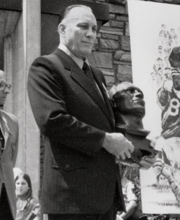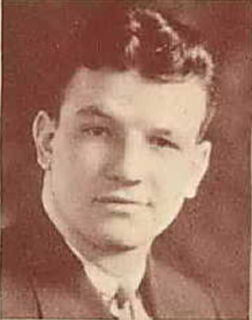Related Research Articles

Samuel Blake Chapman was an American two-sport athletic star who played as a center fielder in Major League Baseball, spending nearly his entire career with the Philadelphia Athletics. He batted and threw right-handed, leading the American League in putouts four times. He was previously an All-American college football player at the University of California.

Frank Manning "Bruiser" Kinard Sr. was an American football tackle and coach and university athletic administrator. He was inducted into the College Football Hall of Fame as a charter member in 1951 and into the Pro Football Hall of Fame in 1971.

Edwin Clarence Widseth was an American professional football player who was a tackle for the New York Giants of the National Football League (NFL) for four seasons. He played college football for the Minnesota Golden Gophers football team of the University of Minnesota, where he was a consensus All-American in 1935 and 1936. Widseth was drafted by the New York Giants in the first round of the 1937 NFL Draft, and was chosen for the Pro Bowl in 1938. He was later inducted into the College Football Hall of Fame.

Harry Lawrence Newman was an All-Pro American football quarterback. He played for the University of Michigan Wolverines (1930–32), for whom in 1932 he was a unanimous first-team All-American, and the recipient of the Douglas Fairbanks Trophy as Outstanding College Player of the Year, and the Helms Athletic Foundation Player of the Year Award, he was later inducted into the College Football Hall of Fame. He then played professionally for the New York Giants (1933–35), and the Brooklyn/Rochester Tigers (1936–37).

Anthony A. Blazine, Jr. was an American football player and coach. He played college football at Illinois Wesleyan University from 1931 to 1934 and professional football in the National Football League for the Chicago Cardinals and New York Giants from 1935 to 1941. He played at the tackle position. He later served as an assistant football coach at the University of Illinois (1944–1946), University of Nebraska (1947–1948), and Washington State College (1949). He was posthumously inducted into the College Football Hall of Fame in 2002.

Ralph Isaac "Hike" Heikkinen was an All-American guard for the University of Michigan Wolverines football team from 1936 to 1938. He was a consensus All-American in 1938, the first player from the Gogebic Range area of Michigan's Upper Peninsula to win the honor. His exploits were widely reported in the Upper Peninsula press, where he became a local hero. He played professional football in the National Football League (NFL) with the Brooklyn Dodgers in 1939.

The Washington University Bears football team represents Washington University in St. Louis in college football. The team competes at the NCAA Division III level as an affiliate member of the College Conference of Illinois and Wisconsin (CCIW). They are a primary member of the University Athletic Association, of which they were a founding member. They were previously a founding member of the Missouri Valley Conference whose bigger schools split into the Big Eight Conference and then added a few members to form the Big 12 Conference.
The 1973 College Football All-America team is composed of college football players who were selected as All-Americans by various organizations and writers that chose College Football All-America Teams in 1973. The National Collegiate Athletic Association (NCAA) recognizes six selectors as "official" for the 1973 season. They are: (1) the American Football Coaches Association (AFCA) which selected its team for Kodak based on a vote of the nation's coaches; (2) the Associated Press (AP) selected based on the votes of sports writers at AP newspapers; (3) the Football Writers Association of America (FWAA) selected by the nation's football writers; (4) the Newspaper Enterprise Association (NEA) selected based on the votes of sports writers at NEA newspapers; (5) the United Press International (UPI) selected based on the votes of sports writers at UPI newspapers; and (6) the Walter Camp Football Foundation (WC).
The 1934 College Football All-America team is composed of college football players who were selected as All-Americans by various organizations and writers that chose College Football All-America Teams in 1934. The nine selectors recognized by the NCAA as "official" for the 1934 season are (1) Collier's Weekly, as selected by Grantland Rice, (2) the Associated Press (AP), (3) the United Press (UP), (4) the All-America Board (AAB), (5) the International News Service (INS), (6) Liberty magazine, (7) the Newspaper Enterprise Association (NEA), (8) the North American Newspaper Alliance (NANA), and (9) the Sporting News (SN).
The 1980 UCLA Bruins football team was an American football team that represented the University of California, Los Angeles during the 1980 NCAA Division I-A football season. In their fifth year under head coach Terry Donahue, the Bruins compiled a 9–2 record, finished in second place in the Pacific-10 Conference, and were ranked #13 in the final AP Poll.
The 1931 College Football All-Southern Team consists of American football players selected to the College Football All-Southern Teams selected by various organizations for the 1931 Southern Conference football season. Tulane won the Southern Conference championship. In December 2008, Sports Illustrated undertook to identify the individuals who would have been awarded the Heisman Trophy in college football's early years, before the trophy was established. Tulane's Jerry Dalrymple was selected as the would-be Heisman winner for the 1931 season.
The 2014 College Football All-America Team includes those players of American college football who have been honored by various selector organizations as the best players at their respective positions. The selector organizations award the "All-America" honor annually following the conclusion of the fall college football season. The original All-America team was the 1889 College Football All-America Team selected by Caspar Whitney and Walter Camp. In 1950, the National Collegiate Athletic Bureau, which is the National Collegiate Athletic Association's (NCAA) service bureau, compiled the first list of All-Americans including first-team selections on teams created for a national audience that received national circulation with the intent of recognizing selections made from viewpoints that were nationwide. Since 1957, College Sports Information Directors of America (CoSIDA) has bestowed Academic All-American recognition on male and female athletes in Divisions I, II, and III of the NCAA as well as National Association of Intercollegiate Athletics athletes, covering all NCAA championship sports.
The 2016 College Football All-America Team includes those players of American college football who have been honored by various selector organizations as the best players at their respective positions. The selector organizations award the "All-America" honor annually following the conclusion of the fall college football season. The original All-America team was the 1889 College Football All-America Team selected by Caspar Whitney and Walter Camp. In 1950, the National Collegiate Athletic Bureau, which is the National Collegiate Athletic Association's (NCAA) service bureau, compiled the first list of All-Americans including first-team selections on teams created for a national audience that received national circulation with the intent of recognizing selections made from viewpoints that were nationwide. Since 1957, College Sports Information Directors of America (CoSIDA) has bestowed Academic All-American recognition on male and female athletes in Divisions I, II, and III of the NCAA as well as National Association of Intercollegiate Athletics athletes, covering all NCAA championship sports.
The 2017 College Football All-America Team includes those players of American college football who have been honored by various selector organizations as the best players at their respective positions. The selector organizations award the "All-America" honor annually following the conclusion of the fall college football season. The original All-America team was the 1889 College Football All-America Team selected by Caspar Whitney and Walter Camp. The National Collegiate Athletic Bureau, which is the National Collegiate Athletic Association's (NCAA) service bureau, compiled, in 1950, the first list of All-Americans including first-team selections on teams created for a national audience that received national circulation with the intent of recognizing selections made from viewpoints that were nationwide. Since 1957, College Sports Information Directors of America (CoSIDA) has bestowed Academic All-American recognition on male and female athletes in Divisions I, II, and III of the NCAA as well as National Association of Intercollegiate Athletics athletes, including all NCAA championship sports.
The 2018 College Football All-America Team includes those players of American college football who have been honored by various selector organizations as the best players at their respective positions. The selector organizations award the "All-America" honor annually following the conclusion of the fall college football season. The original All-America team was the 1889 College Football All-America Team selected by Caspar Whitney and Walter Camp. The National Collegiate Athletic Bureau, which is the National Collegiate Athletic Association's (NCAA) service bureau, compiled, in the 1950, the first list of All-Americans including first-team selections on teams created for a national audience that received national circulation with the intent of recognizing selections made from viewpoints that were nationwide. Since 1957, College Sports Information Directors of America (CoSIDA) has bestowed Academic All-American recognition on male and female athletes in Divisions I, II, and III of the NCAA as well as National Association of Intercollegiate Athletics athletes, including all NCAA championship sports.
The 1935 Little All-America college football team is composed of college football players from small colleges and universities who were selected by the Associated Press (AP) as the best players at each position. For 1935, the AP did not select a second team but instead chose multiple players for "honorable mention" at each position.
The 1939 Little All-America college football team is composed of college football players from small colleges and universities who were selected by the Associated Press (AP) as the best players at each position. For 1939, the AP selected both a first team and a second team.
The 1952 Little All-America college football team is composed of college football players from small colleges and universities who were selected by the Associated Press (AP) as the best players at each position. For 1952, the AP followed the precedent established in 1951 by selecting three separate groups: a first team consisting of separate offensive and defensive platoons, and a second team consisting of 11 players.
The 1957 Little All-America college football team is composed of college football players from small colleges and universities who were selected by the Associated Press (AP) as the best players at each position. For 1957, the AP selected three teams of 11 players each, with no separate defensive platoons.
The 1963 Little All-America college football team is composed of college football players from small colleges and universities who were selected by the Associated Press (AP) as the best players at each position. For 1963, the AP selected three teams of 11 players each, with no separate defensive platoons.
References
- ↑ "Small School All-American Teams Chosen". The Tacoma Daily Ledger. December 5, 1934. p. 7 – via Newspapers.com.